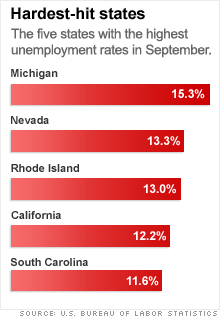State jobless picture brightens a little
In September, 23 states saw jobless rates rise, government says. But Michigan remains hardest hit at 15.3%, and the national rate stands at a 26 year high.

NEW YORK (CNNMoney.com) -- Fewer states posted an increase in unemployment in September, even as the national rate recently hit a 26-year high of 9.8%.
Jobless rates increased in 23 states and the District of Columbia last month, according to a report released Wednesday by the Labor Department.
Additionally, 19 states posted a decrease in unemployment, and eight states had rates hold steady in September.
That's compared to August, when 27 states and the District of Columbia recorded month-over-month unemployment rate increases.
Bad news still dominates. The overall employment picture remains very grim. All 50 states and the District of Columbia reported an increase in unemployment compared with September 2008.
And the national unemployment rate is widely expected to push above 10%, even as the economy has started showing some signs of turnaround. Nationwide, September marked the 21st consecutive month that the total number of workers on payrolls shrunk, with 7.2 million jobs lost during that period.
Michigan remains the state hardest hit by unemployment, with a rate of 15.3%. It reported the biggest year-over-year jump, up 6.4 percentage points. Nevada had the next-highest rate, 13.3%, followed by Rhode Island at 13% and California, at 12.2%.
Florida, with 11% unemployment, as well as Nevada and Rhode Island, all posted the highest unemployment rates on record since the survey of states began in 1976.
A total of 15 states reported jobless rates above 10% in September, according to the federal data.
A few bright spots: North Dakota again posted the lowest jobless rate in September, at 4.2%. It was followed by South Dakota, with 4.8%; Nebraska, at 4.9%; and Utah, at 6.2%. Five states were tied for the next lowest rate of 6.7%.
Nineteen states reported declines in joblessness from August. Minnesota and Ohio each posted the biggest declines, at 0.7 percentage point, while rates in Oregon and Wisconsin both dipped by 0.5 percentage point.
But even that good news isn't all that good. In Ohio, for example, the unemployment rate has fallen to 10.1%, down 1.1 percentage points from July. However that's probably just because discouraged job-hunters are giving up the search altogether, according to Brian Harter of the Ohio Department of Job and Family Services, which means that they aren't counted in the unemployment rate survey.
"Some are frustrated because they cannot find work," he said in an e-mail, "while others are going back to school so they can retrain themselves to re-enter the workforce in a different vocation."
Meanwhile, as the economic downturn drags on, more people across the country are losing their unemployment benefits. Congress is debating measures that would extend these benefits to the unemployed. The House has approved an extension but the Senate has not yet voted on it.
In a Senate Democrats' proposal, unemployment benefits would be extended by up to 14 weeks in every state, and then another six weeks on top of that in states where the unemployment rate tops 8.5%. Currently, states with rates above 8% now offer up to 79 weeks of benefits. States with rates between 6% and 8% now offer up to 59 weeks, and all other states currently offer up to 46 weeks. ![]()


